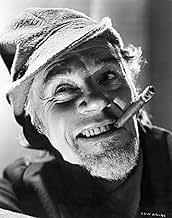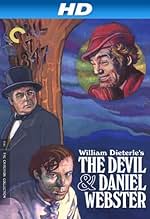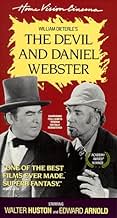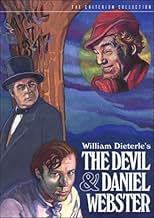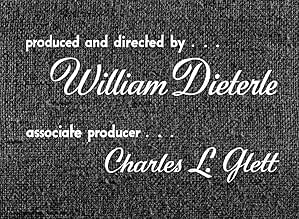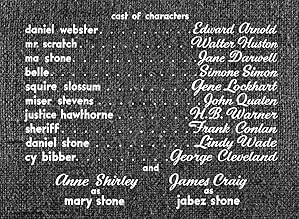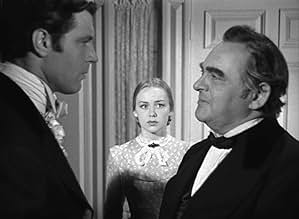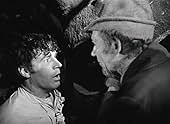En el siglo XIX, un granjero de New Hampshire hace un pacto con Satanás para conseguir el éxito económico, y luego recurre al famoso orador Daniel Webster para que lo libere de su contrato.En el siglo XIX, un granjero de New Hampshire hace un pacto con Satanás para conseguir el éxito económico, y luego recurre al famoso orador Daniel Webster para que lo libere de su contrato.En el siglo XIX, un granjero de New Hampshire hace un pacto con Satanás para conseguir el éxito económico, y luego recurre al famoso orador Daniel Webster para que lo libere de su contrato.
- Dirección
- Guión
- Reparto principal
- Ganó 1 premio Óscar
- 2 premios y 1 nominación en total
- Spectator
- (sin acreditar)
- Hank
- (sin acreditar)
- Poker Player
- (sin acreditar)
- Woman
- (sin acreditar)
- Martin Van Buren Aldrich
- (sin acreditar)
Reseñas destacadas
A cautionary tale of greed and power, the narrative centers around the character of Jabez Stone (played by James Craig), a down-on-his-luck farmer who is barely able to support his family in 1840s New Hampshire. When the nefarious Mr. Scratch (Walter Houston) appears during a moment of weakness, Jabez agrees to sell his soul in exchange for seven years of good luck. Much to the dismay of his wife (Ann Shirley), mother (Jane Darwell), and beloved politician Daniel Webster (Edward Arnold), Jabez slips into a downward spiral as a result of his newfound wealth and power. When his seven years are up, Jabez learns the error of his ways and wants to make amends. To escape his contract with the devil, Jabez puts his fate in the hands of the almost mythic Daniel Webster, who represents him in a climactic barn room trial against Mr. Scratch and a jury of the damned.
The execution of this story is remarkable, from the elegant direction and incredible performances to the innovative camera work and stylish mise-en-scene. Dieterle infuses the film with stark contrast lighting and masterful compositions rich in detail and multiple layers of action. When Mr. Scratch appears in Jabez's barn, he is heavily backlit and accompanied by ethereal sounds. His accomplice, the creepy Belle, is similarly introduced beside a fireplace. To portray the film's more ghostly effects, including Belle's dance to the death with Miser Stevens and the barn room trial, Dieterle relies on multiple exposure and diffused lighting. These visual effects and others, such as items bursting into flame, were ahead of their time - as were the lighting schemes. Influenced as Citizen Kane was by German expressionist films, The Devil and Daniel Webster features bold, suggestive lighting where shadows alone often represent a character. Dieterle succeeds in creating a visual distinction between the real world and the netherworld by frequently bathing Scratch and Belle in soft light or diffusion and removing all natural sounds from the soundtrack when they appear. Belle's dance of death and Scratch's fiddle playing at Jabez's party are accompanied by severe under lighting, insinuating the hellish forces at work in both scenes. Every shot in the film, even in the mundane world, seems painstakingly planned and executed, with decisive lighting and many intricate camera movements, rare for this era of film-making.
The most remarkable performance in the film is Walter Houston's Mr. Scratch.
Houston, an Oscar-winner for his role in Treasure of the Sierra Madre, exudes unbridled glee with every devilish grin. His devil is a gentleman-like puppet master, a smooth talker, and very persuasive. He never flaunts his evil powers. He doesn't have to. His appeal is understandable because he can offer what everyone in the movie wants - wealth and power. It's easy for the Devil to sell his wares to struggling farmers, so he's confident and playful in his duties. Houston throws away one-liner after one-liner, owning the screen and stealing the show. At one point, he offers to help Daniel Webster win the presidential election. Webster replies, "I'd rather see you on the side of the opposition." As Webster walks away, Houston replies, "Oh, I'll be there, too," and sticks a cigar in his mouth.
To combat the devil, Dieterle cast Edward Arnold (who was actually recast when the original actor was injured during filming). Arnold had a tough job in the film, making believable not only Daniel Webster's mythic stature, but also his flowery rhetoric about patriotism and the goodness in all men. He admirably succeeds in not only persuading the jury of the damned, but in holding his own against Walter Houston in their many scenes together.
Everyone else in the cast is also excellent. James Craig pulls off Jabez Stone's fall from grace, and Ann Shirley is a believable virtuous wife. Jane Darwell, fresh off her Oscar-winning stint as Ma Joad in The Grapes of Wrath, seems to be playing the same character in The Devil and Daniel Webster, but it serves the movie well. The most notable supporting player is Simone Simon, whose mesmerizing Belle haunts every frame in which she appears. It's easy to see why Jabez would fall under her spell, because we, as an audience, do as well.
The icing on the Devil's cake is Bernard Herrmann's Oscar-winning score, a dynamic one that works on many levels. Herrmann incorporates several traditional folk songs into his original music, including "Devil's Dream", "Springfield Mountain", and "Miss McLeod's Reel". For Mr. Scratch and Belle, Herrmann manipulated the sound of telephone wires "singing" in the wind to create an eerie, atonal sound for the netherworld. The film also provided Herrmann a wealth of other opportunities, including a square dance and two lullabies.
A good story makes a movie worth watching once. Exquisite aesthetics makes it worth watching many times. The Devil and Daniel Webster stands the test of time as an endearing narrative with lessons we have still to learn. It's masterful direction and style, fluid editing, and charming performances make it an accessible and entertaining film for any audience. Now restored and widely available, it is sure to join the ranks of those other great classics from the late '30s and early '40s - a scintillating example of good storytelling and fine craftsmanship.
- Scott Schirmer
The Criterion DVD helped me appreciate the underrated black-and-white cinematography in this movie. It simply looks super, and even the special-effects are still pretty darned good considering the year this was made.
Character-wise, as so often is the case, the bad-guys are the most interesting in the movie. The best was Walter Huston playing "Scratch" (the Devil) and Simone Simon playing a female helper of his. Simon has the allure in this story to drive leading character "Jabez Stone" away from his sweet wife "Mary" (Anne Shirley).
Depressed and whining over his financial state of affairs and general lot in life, "Jabez" is ripe pickings for the wily "Scratch" and his cohort. The Devil makes Stone sign away his soul for money, prosperity, power, etc. Jabez gets carried away with his greed and winds up learning some valuable lessons.
Meanwhile, Edward Arnold plays "Daniel Webster," a folk hero during this time period, a man revered by all in New England. He winds up defending Jabez in a court-like scene i the end to see if he can win back the man's soul. Arnold is captivating in his role as Webster and gives an old-fashioned patriotic message at the end which would make today's Hollywood filmmakers sick.
Craig, who gets 12th billing in this film - go figure - has the most lines in the movie! How can be ignored, not only on the DVD and VHS boxes but on the bottom of the credits on this IMDb cast page? Craig overacts in his role and, thus, becomes a little annoying at times. Shirley might have been the most attractive I've ever seen here, mainly because of her strong, Christian character and down-home plain beauty that shines through in this character, Jabez's faithful wife "Mary." (She also gets slighted in the billing.)
Overall, this is a different story than anything you've seen. It's interesting, nicely directed by William Dieterle and photographed by Joseph August. Sadly, the latter died later in this decade with a heart attack. His last picture was another visual wonder: "Portrait Of Jennie."
"The Devil & Daniel Webster", a.k.a. "All That Money Can Buy", retells the timeless German classic story of Faust, a man that sells his soul to Mephistopheles. The film has not aged after more than seventy years. The dance of Belle with her guests is eerie and seems to be the source of inspiration of the dance in "Carnival of Souls". Walter Huston and Edward Arnold have great performances in the roles of Mr. Scratch and Edward Arnold respectively. My vote is seven.
Title (Brazil): Not available on Blu-Ray or DVD
Funny: Huston as ol' Mr. Scratch was SO good. Very funny, cynical wit. Lots of little things that stand out from him, all the odd places he turns up. He's everywhere, leading the band at the parade for Dan'l, in Washington whispering in the senator's ear, playing a mean fiddle at the barn dance. His insults to Jabez Stone were priceless. The bit at the end of him ravenously devouring this huge pie was a really funny demonstration of his greed, and the final moments of examining his book for the next target are priceless.
Creepy: Between all the funny stuff were the implications of hell and damnation, but especially terror and hopelessness (Stone and Miser Stevens). The visitors at Stone's new mansion really creeped me out good. Also creepy was the infamous scene where Miser Stevens recently harvested soul comes flying out of Scratch's jacket pocket screaming for help. This also counts as funny, at least when my five year old nephew and I go around effecting high-pitched squeals begging "Help me Neighbor Stone."
Sexy: Belle, the French nanny/whore that Scratch sent Jabez was hotter with her clothes on and no direct sexual behavior than the hookers making out in the elevator to entertain Al Pacino in "The Devil's Advocate." Note the exact tone and body language of her mocking rebuff to Stone at the barn dance saying "Oh, NO Mr. Stone- your place is with your WIFE."
The hottest thing in the movie (and one of the creepiest things) is the scene where she is singing some evil otherworldly lullaby to Stone's infant son. Rewind and watch it closely a couple of times. What was she singing?
Surely this is one of the greatest forgotten movies of the era. This should be making some of those AFI top 100 list thingeys.
One word - "fantasy". It's my favorite movie category, and this is the best one that I've ever seen. The 1940s was the decade in which horror melodramas and fantasies really began to ramp up, and this movie helped to set the standard. Stephen Vincent Benet's story is a bit changed, but not enough to diminish this American Gothic tale.
Aside from being superior entertainment, the movie simply has no weaknesses. Where to start? The casting and acting are extraordinary. Though both are most often remembered for other movies, Edward Arnold and Walter Huston turn in their best performances here. Simone Simon (known today for the "Cat People" movies) is exceptional as Belle. Anne Shirley, James Craig, and the stellar supporting cast are also great.
This is Bernard Herrmann's best film score. William Dieterle's direction is quirky and involving, propelling the film along at a fast clip. Admittably, the characters are caricatures, but Dieterle helps us to feel their trials and tribulations. The movie also features brilliant cinematography, exceptional production values, and truly superior editing (this was an early job for director Robert Wise). The scenes are quite stagey, but never disjointed - the logic of the story is unmistakable and riveting.
Huston is the ultimate "Mr. Scratch". I've seen this show many times, and it's a 10/10.
¿Sabías que...?
- CuriosidadesWilliam Dieterle had a habit of directing with white gloves on. Robert Wise said that everyone thought it was because he had a germ or dirt phobia. During shooting of one scene, Dieterle noticed there wasn't enough mud on a carriage wheel. He pulled off his gloves, grabbed some mud, rubbed it onto the wheel, then wiped his hands on his pants and put the gloves back on to continue directing.
- PifiasShortly after filming had begun, Thomas Mitchell fractured his skull and was replaced by Edward Arnold. Not many scenes had been shot, none were reshot, so Mitchell is still visible in some scenes. [Note: entries in the Trivia section indicate that all of Mitchell's scenes were reshot.]
- Citas
Mr. Scratch: You shall have your trial, Mr. Webster. But I'm sure you'll agree, this is hardly the case for an ordinary jury.
Daniel Webster: Let it be the quick or the dead, so long as it is an American judge and an American jury!
Mr. Scratch: 'The quick or the dead!' You have said it.
[he stomps on the barn floor; a door opens]
Mr. Scratch: You must pardon the leathery toughness of one or two.
Jabez Stone: [afraid] Mr. Webster!
[a line of ghosts begin entering from the trapdoor]
Mr. Scratch: Captain Kidd - he killed men for gold. Simon Girty, the renegade - he burned men for gold. Governor Dale - he broke men on the wheel. Asa, the Black Monk - he choked them to death. Floyd Ireson and Stede Bonnet, the fiendish butchers. Walter Butler, King of the Massacre. Big and Little Harp, robbers and murderers. Teach, the Cutthroat. Morton, the vicious lawyer... and General Benedict Arnold. You remember him, no doubt.
Daniel Webster: A jury of the damned...
Mr. Scratch: [laughs] Dastards, liars, traitors, knaves. Your suggestion, Mr. Webster - 'the quick or the dead.'
Daniel Webster: This is outrageous, I asked for a fair trial...
Mr. Scratch: Americans, all.
- Créditos adicionalesFor some prints released under the title "The Devil and Daniel Webster", the opening credits start with the phrase "in front of the camera..." followed by a list of names only of the primary cast (no character names) and then the phrase "in back of the camera..." followed by a list of names only of the primary production crew, without their job roles, ending with the phase "all collaborated on the picture...." Then the title card is shown, with a story credit to Stephen Vincent Benet, and the note "this picture was originally shown with the title 'all that money can buy'." The title card is all in lower case. Finally, the opening prologue is shown as noted in another crazy credit item.
- Versiones alternativasOver the years, this film was re-released more than once, partly because of its poor box office, and gradually cut down to 85 minutes. It remained in this form for many years, until it was recently restored to its full length. When this was done in the 1990s, it was unfortunately all too easy to tell which sections are restored... all the footage from the 85 minute version was in absolutely pristine, mint condition, while the long-lost, formerly missing footage has less than perfect sound and picture quality. However, the quality has been considerably improved on the DVD and on recent TV showings.
- Banda sonoraCome, Ye Thankful People, Come
(uncredited)
Music by George J. Elvey
Lyrics by Henry Alford
Selecciones populares
- How long is The Devil and Daniel Webster?Con tecnología de Alexa
Detalles
- Fecha de lanzamiento
- País de origen
- Idioma
- Títulos en diferentes países
- Un pacto con el diablo
- Localizaciones del rodaje
- Empresa productora
- Ver más compañías en los créditos en IMDbPro
- Duración
- 1h 47min(107 min)
- Color
- Relación de aspecto
- 1.37 : 1


